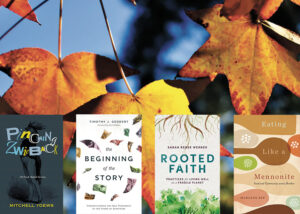Feeling like a pandemic leper
I really appreciate the three articles Will Braun wrote regarding the polarization of vaccines (“The sweet solace of polarization,” Oct. 3, Oct. 17, Oct. 31, 2022).
I am immunocompromised and was the first member of my church to get COVID-19, back in November 2020. After the two-week quarantine, I got much worse, with breathing difficulties and high fever.
So once the vaccine was authorized for usage—without prolonged testing—and then mandates introduced, I really felt like a leper. Having chosen not to get vaccinated, I was banned from taking my elderly dad to hospital, banned from a nephew’s wedding, told I could not attend my favourite pastor’s funeral nor attend my friend’s celebration of life reception.
Yet, as a waitress, I could work every day in public. When Canadian Mennonite magazine printed articles about how important it was to follow government mandates and get vaccinated as a way to show that we loved our neighbour as ourselves, I was mystified and a bit confused. At times I felt that CM was another arm of the government.
Yet I enjoyed other articles and so did not cancel my subscription.
All of my kids and husband had been double vaccinated, but they understood my perspective and choice. I accepted others’ choices and responses as well, despite often feeling judged and discriminated against.
I was prohibited from seeing my ailing mother-in-law in long-term care for over a year, so I eventually made the choice to get vaccinated, even if it put my own health at risk. Ironically, the mandate requiring proof of vaccine was lifted a few weeks later!
So thanks, Will, for your willingness to see and understand the other side.
—Maria Siemens Matty, Abbotsford, B.C.
The writer attends Emmanuel Mennonite Church, Abbotsford, B.C.
Giving should reach beyond Mennonite causes
Re: “The how and why of Christian giving,” Nov. 28, 2022.
I wish to augment the helpful comments of this article, in particular with regard to money.
It would be in our Christian interest to expand our giving beyond the Mennonite environment. There are voices within our regional area and outside the church that request and need our assistance. I am conscious of the Food Bank, Gleaners and those in our city tents.
Friends outside our conventional church circles request help. Our younger years undoubtedly exposed us to people involved in Christian ministry, but not within the Mennonite church. A few examples are Inter-Varsity Christian Fellowship of Canada, Mission Aviation Fellowship, Wycliffe Bible Translators, Latin American Mission and Trans World Radio Canada. As people of God, these, too, are within the body of the global church.
There was no mention of tithing, a voice we did hear from our pulpits a few decades back. Does this Old Testament discipline no longer apply?
The column made frequent mention of “perceived needs,” and “what we can “give.” Most of us make comparisons with others around us, including fellow church members. A consideration could be the other 90 percent of the world’s people who are in greater physical, mental and, for many, spiritual need.
—John F. Peters, Waterloo, Ont.
The writer is a member of Waterloo North Mennonite Church.
Reader corrects location of famous oak
Re: “An ‘accidental visiting scholar,’ ” Nov. 14, 2022.
The article includes a photo of the offspring of the Chortiza oak tree, which grows in Winnipeg. It states that the original oak tree was a landmark on the Chortiza Island in Ukraine.
Actually, the 800-year-old oak tree stood on the outskirts of the village of Chortiza, which was part of the first village where our ancestors settled; it did not grow on the island.
Those of us who took part in the Mennonite heritage tours all visited this tree in the village of Chortiza.
This mistake had also been printed in the past; this time I thought it needed correction.
—Melita Penner, Saskatoon
More women in the Bible were objectified than identified positively
Re: “Women who prepared the way for Jesus” feature, Nov. 28, 2022.
It is good that there are women identified positively in the biblical literature who paved the way for Jesus.
I think the larger picture we could glean from women in biblical literature is that they were more often than not objectified; chattels; spoils of war; virgins given to conquering warriors; sex objects lusted after by major biblical characters (David/Bathsheba); members of harems (Esther); raped by family members or political and religious leaders (Dinah); punished by exposure of their genitalia to the public and invitation to be beaten (Hosea); and, in general, subject to the patriarchy of every generation leading up to Jesus. These women, too, all paved the way for Jesus.
It is vital for us to recognize that the misogyny of women in the biblical literature has followed us into the 21st century, even in Anabaptist Mennonite cultures, well beyond Jesus’ arrival and departure from this fair earth.
While we acknowledge the biblical women identified, such as Rahab, Mary and Anna, I think some of the more salient questions of Anabaptist Mennonites to ponder should include:
- How is misogyny manifested within Mennonite church leadership and Mennonite academia?
- How is misogyny manifested within Mennonite homes?
- How do we participate in misogynistic systems in our society?
To my mind, we have a tendency to romanticize Christmas and Jesus’ arrival. Of course, it is good news. However, I hope we continue to acknowledge the grim reality of misogyny in much of the biblical literature, and that we see Jesus’ arrival as good news that there is no room for misogyny in the Anabaptist/Mennonite inn.
—Peter Reimer (online comment)
Column strikes a chord for reader
Re: “The paradox of enoughness” column, Oct. 3, 2022.
This column really struck a chord for me.
Some years ago I read the book Wisdom Distilled from the Daily: Living the Rule of St. Benedict Today by Joan Chittister. It left a significant impact on my thinking and, in particular, the line from the Rule which says, ‘Don’t demand the best of everything.”
Wise advice in a society that encourages never-ending consumption and constant striving for more.
Thanks for Troy Watson’s cogent and very well expressed thoughts.
—Paul Thiessen, Vancouver
John misperceived in Advent feature
Re: “Listening to the Spirit, with John,” Nov. 14, 2022.
My understanding is that John followed the traditions and practices of being a Nazirite. A Nazirite followed the practices of no alcohol, etc., and was known in Old Testament times to be devout and dedicated to God. John’s lifestyle and dedication to God were probably a big part of the reason why crowds were attracted to him.
I find the article portrays John in extreme language that I doubt was how he was perceived by his fellow Jews and listeners. I am impressed that his message also resonated with the soldiers who, I presume, were part of the Roman army and not Jewish by faith or heritage.
—Linda Petty (online comment)
Column is a true ‘Christmas delight’
Re: “Christmas delight?” column, Dec. 12, 2022.
What a lovely piece, unpacking through storytelling and direct experience the true unexpected and simple origins of genuine delight, as opposed to our many manufactured attempts—be it through consumerism or flashy services—to make it happen.
—Blake Poland (online comment)
Request for clarification on what lies beyond inclusion
The article, “Queer theology pushes beyond inclusion” (Nov. 28, 2022) reads as follows: ‘The question of inclusion is not even the most helpful, or interesting, question’, [Melanie Kampen] said, noting that, with inclusion, ‘you’ve just widened your circle to include another group of people. But it doesn’t change anything about the structures that made exclusion of those people possible in the first place.’
What lies beyond inclusion? What structures should be eliminated and, if there were new structures, what would they be?
—David Shantz, Montreal










Leave a Reply
You must be logged in to post a comment.